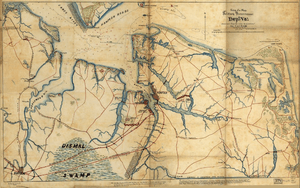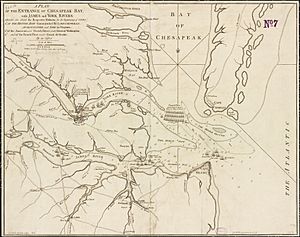Second Battle of the James River (1673) facts for kids
Quick facts for kids Second Battle of the James River (1673) |
|||||||
|---|---|---|---|---|---|---|---|
| Part of the Franco-Dutch War and Third Anglo-Dutch War | |||||||
 Map of the battle area |
|||||||
|
|||||||
| Belligerents | |||||||
| Commanders and leaders | |||||||
| Strength | |||||||
| 9 ships | 8 ships | ||||||
| Casualties and losses | |||||||
| only 3 men dead no ships lost |
4 ships captured several more that where not participating in the battle |
||||||
The Second Battle of the James River, also known as the Battle of Lynnhaven Bay, was a naval fight between a Dutch fleet and an English squadron. It happened on July 12 and 13, 1673 (Old Style dates, or July 22-23, 1673 New Style dates). The battle took place near the James River in Hampton Roads, during the Third Anglo-Dutch War. The Dutch fleet was led by Admirals Cornelis Evertsen the Youngest and Jacob Binckes.
Why the Battle Happened
In 1667, during the Second Anglo-Dutch War, a Dutch admiral named Abraham Crijnssen attacked the James River. He captured English merchant ships loaded with tobacco from the Colony of Virginia and the Province of Maryland. Tobacco was a very important product for the English colonies in North America.
The English had laws called the Navigation Acts. These laws said that only English ships could trade with their colonies. This meant the Dutch were not allowed to buy tobacco directly. So, during wartime, the Dutch navy wanted to capture or destroy as much tobacco as possible.
When the Third Anglo-Dutch War started a few years later, the Dutch navy again wanted to disrupt England's tobacco trade. Two groups of Dutch ships, called squadrons, were sent out. One was led by Cornelis Evertsen and the other by Jacob Binckes. Their mission was to attack English and French ships in the Western Hemisphere.
These two squadrons met up in the Caribbean. After taking back some islands from the English, they decided to attack the English colonies along the Atlantic Seaboard. They wanted to do what Admiral Crijnssen had done in the previous war.
Because of Crijnssen's earlier raid, the governor of Virginia, William Berkeley, asked England for more warships. In the spring of 1673, he received two English warships, called frigates: HMS Barnaby and HMS Augustine. These two ships would form the main part of an English fighting force. This force also included armed merchant ships. Their job was to protect the combined tobacco fleets from Virginia and Maryland, which were getting ready to sail to England in early July 1673.
The Battle Begins
On July 11, 1673, the Dutch fleet, which had about 20 ships (including some they had captured), entered the Chesapeake Bay. They dropped anchor in Lynnhaven Roads. From there, they could see the masts of the Virginia tobacco fleet in the Hampton Roads.
At first, the English decided to wait and defend themselves. But on the morning of July 12, 1673, something unexpected happened. Eight ships from the Maryland tobacco fleet appeared, sailing directly towards the Dutch fleet without knowing the danger. The English warships had to act quickly. They needed to attack the Dutch to distract them. This would lure the Dutch away from their important position and prevent the Maryland ships from being captured easily.
The English commander faced a big problem. The Dutch ships were anchored in a spot that blocked the escape route for the Maryland merchant ships. This spot was near the "tail" of the triangular Horseshoe Shoals. Ships had to sail around this point to get into the James River. The English warships needed to move in a way that gave the merchant ships enough room to get around this point, without hitting the shallow ground or getting hit by Dutch cannons.
The Dutch also had the "weather gage." This meant they were upwind of the English ships. So, the English ships had to sail against the wind to reach the Dutch. When sailing against the wind, ships lean over. This meant their lower cannons on one side would be underwater and couldn't be used.
Many of the sailors on the merchant ships, who had been forced to join the two English frigates, were not ready for this kind of fighting. Four of these ships ran aground (got stuck in shallow water) before any shots were even fired. A fifth ship simply sailed away. Only one armed merchant ship, led by Captain Grove, stayed with the two English warships.
When the three remaining English ships got close to the anchored Dutch ships, they quickly turned and sailed with the wind towards the James River. The Dutch ships took the bait. They pulled up their anchors and followed. At this point, Captain Grove's ship also ran aground.
HMS Barnaby then attacked the Dutch flagship, Swaenenburgh, which was Admiral Evertsen's ship. HMS Barnaby quickly turned and sailed across the front of Swaenenburgh, firing all its cannons at the same time. Meanwhile, HMS Augustine continued towards the mouth of the Elizabeth River after firing just one round of cannons at the Dutch.
Captain Gardiner, on HMS Barnaby, fought alone for hours against Swaenenburgh and the other Dutch warships. The fight only stopped when it got dark. The Dutch then began to capture the English ships that were stuck. They captured four ships. But while sailing to join Admiral Binckes' anchored ship, Swaenenburgh also ran aground because it misjudged the shallow areas. Luckily, it managed to get free during the night.
While the battle was happening, most of the Maryland ships escaped past the Virginia Capes. Most of the Virginia tobacco fleet escaped up the James River towards Jamestown. There, they hoped to find safety under the cannons of Fort Nansemond, even though the fort's defenses were not very strong.
After the Battle
Because of the many shallow areas in the James, Nansemond, and Elizabeth rivers, the Dutch ships kept their distance for five days. They kept getting stuck, so they couldn't reach the main tobacco fleet. They were only able to burn the four ships that had run aground and two others they had captured.
During this waiting period, the Dutch captured several other ships that were not expecting trouble. One of these was a small ship called a ketch, captained by Samuel Davis. This little ship had important passengers, including James Carteret, the son of George Carteret, who owned the New Jersey colony. His bride, Francess Delavall, was also on board, along with Samuel Hopkins. Carteret and Hopkins were involved in a plan against the governor of New Jersey.
At first, the Dutch commanders did not realize how important Carteret and Hopkins were. Carteret and his bride were soon released. Carteret even helped arrange a trade of prisoners with Governor Berkeley. But a few days later, when Evertsen questioned Hopkins and Captain Davis more closely, Hopkins let slip some important information. He said that Governor Lovelace of the New York colony (which used to be the Dutch colony of New Netherland) was away from his post. He also said that Fort James on Manhattan (which used to protect New Amsterdam, now New York) was not well defended.
This information made Evertsen and Binckes decide to try and surprise the fort. They landed their marines on Manhattan. This led to the Dutch recapturing New Netherland on July 30, 1673 (Old Style dates), or August 10, 1673 (New Style dates).
Sources


